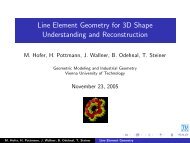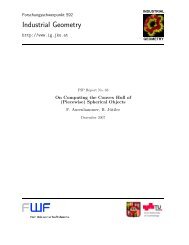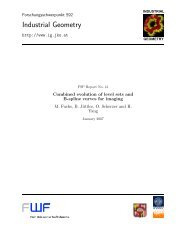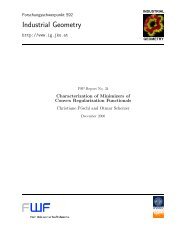Solving constrained ill-posed problems using Ginzburg-Landau ...
Solving constrained ill-posed problems using Ginzburg-Landau ...
Solving constrained ill-posed problems using Ginzburg-Landau ...
You also want an ePaper? Increase the reach of your titles
YUMPU automatically turns print PDFs into web optimized ePapers that Google loves.
2 F. FRÜHAUF, H. GROSSAUER AND O. SCHERZER<br />
zero level set of the function φ. Considering characteristic functions as level sets of<br />
higher dimensional data has been used before in the context of multiphase flow (see<br />
e.g. [16, 22, 6]) and segmentation (see e.g. [5]). Level set methods have been used<br />
successfully in many applications since the pioneering work of Osher and Sethian [19].<br />
For solving inverse <strong>problems</strong> with level sets we refer to [20, 4, 8].<br />
Another possibility to constrain z to be in P is by introducing an appropriate<br />
penalizer. To solve (1.1) under constraint C1 we minimize the functional<br />
(1.5)<br />
1<br />
2 ‖F (z) − y‖2 Y + αS ɛ (z) .<br />
We denote minimizers of (1.5) by z ɛ,α . The functional S ɛ is taken in such a way, that<br />
for ɛ → 0 we have z ɛ,α (x) ∈ {1, 2}. We choose a real <strong>Ginzburg</strong>-<strong>Landau</strong> (GL) type<br />
functional as regularizer S ɛ in (1.5), which means<br />
∫ ( ɛ<br />
S ɛ (z) :=<br />
2 |∇z|2 + 1 )<br />
(1.6)<br />
ɛ W (z) dx<br />
Ω<br />
where W is an appropriate potential. Such GL functionals were also used in topological<br />
optimization, see [14] or for modelling immiscible fluids, cf. [1, p.99].<br />
Next we consider constraint C2. A standard approach for solving nonlinear <strong>problems</strong><br />
is regularization. Therefore we minimize<br />
(1.7)<br />
1<br />
2 ‖F (z) − y‖2 Y + αR(z) .<br />
<strong>Solving</strong> such nonlinear <strong>problems</strong> is discussed in [17, 18, 7], where classical results on<br />
convergence and stability are described.<br />
To make use of the a-priori knowledge that z has values in [a, b] we take a complex<br />
GL regularizer. We achieve this by <strong>using</strong> a complex valued function v with real part<br />
z = R(v) and minimize<br />
1<br />
(1.8)<br />
2 ‖F (z) − y‖2 Y + αT (v) .<br />
We choose as regularizer a complex GL functional<br />
∫ ( λ<br />
T (v) :=<br />
2 |∇v|2 + 1 )<br />
(1.9)<br />
λ W (v) dx ,<br />
Ω<br />
where W is taken in an appropriate way to enforce z ∈ [a, b].<br />
So far such functionals were applied in digital inpainting to reconstruct missing<br />
areas in pictures, cf. [10]. Equations like (1.9) have proven to be useful in several<br />
areas, for example to describe phase transitions in superconductors near critical temperatures,<br />
cf. [13], or to model some types of chemical reactions like the famous<br />
Belousov-Zhabotinsky reaction, to specify boundary layers in multi-phase systems,<br />
and to describe the development of patterns and shocks in non-equilibrium systems,<br />
cf. [11, 15, 21]. To the best of our knowledge complex regularization functionals have<br />
not been used for solving <strong>ill</strong>-<strong>posed</strong> operator equations with constraint C2.<br />
Note that in C1 we are only interested in reconstructing the shape of D whereas<br />
in C2 we have the possibility to determine concrete values of z.<br />
The outline of this paper is as follows. In section 2 we describe the regularization<br />
methods considered in this paper. The existence of minimizers is guaranteed. Furthermore<br />
the optimality conditions and the numerical implementation for an inverse<br />
conductivity problem is described in section 3. Finally, in section 4 we present some<br />
results and discuss them.







